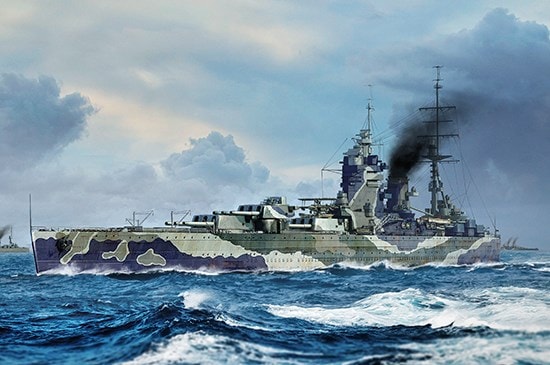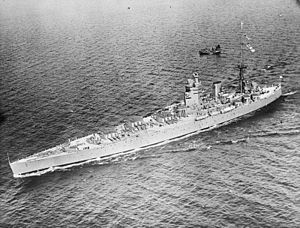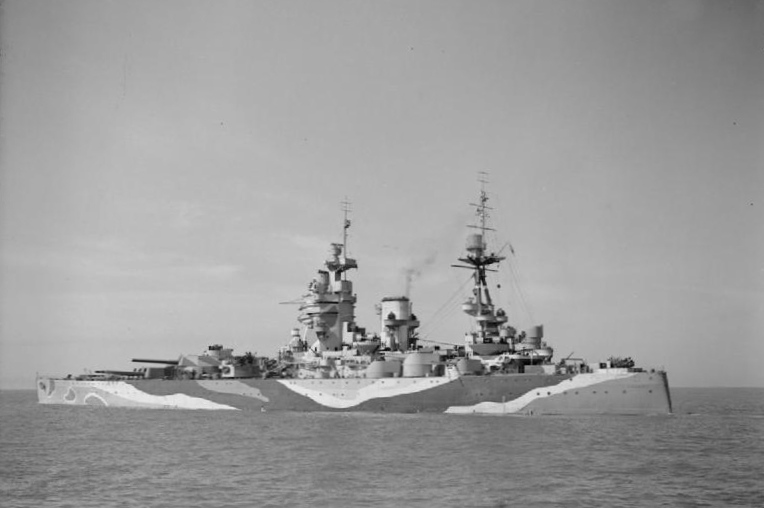Description: Includes: Plastic sprue, Photoetched fret, Decalsheet (waterslide), Rod. Same basic model as HMS Nelson kit 06717.
Class: The Nelson class was a class of two battleships (Nelson and Rodney) of the British Royal Navy, built shortly after, and under the terms of, the Washington Naval Treaty of 1922. They were the only British battleships built between the Revenge class (ordered in 1913) and the King George V class, ordered in 1936.
The ships were named after famous British admirals: George Brydges Rodney, 1st Baron Rodney of the Battle of Cape St. Vincent and Horatio Nelson, 1st Viscount Nelson of the Battles of the Nile and Trafalgar.
To comply with the limitations of the Washington Treaty, these ships were of an unusual design with many novel features. They are often referred to as the first treaty battleships. The Nelsons were unique in British battleship construction, being the only ships to carry a main armament of nine 16-inch (406 mm) guns. The most unusual feature however, and one that is immediately noticeable, is that these were all carried forward of the bridge.
Commissioned in 1927–29, the Nelsons served extensively in the Atlantic, Mediterranean, and Indian oceans during World War II. Rodney was made famous by her role in the sinking of the German battleship Bismarck in May 1941. At the climax of the battle Rodney, in conjunction with King George V, closed on Bismarck to bombard her at short range. Rodney's main guns were credited with an estimated 100 to 130 hits, contributing greatly to her final destruction. Nelson participated in the bombardment of targets in northern France during and after D - Day. In particular, during the Caen campaign she was credited with destroying a group of five Tiger tanks which ventured into a red zone (within 40 km. of the Coast) deemed by the German command to be in range of allied battleships.
The two ships of the class survived the war, but were scrapped in 1948–49 along with almost all other British battleships except Vanguard.
The ships were named after famous British admirals: George Brydges Rodney, 1st Baron Rodney of the Battle of Cape St. Vincent and Horatio Nelson, 1st Viscount Nelson of the Battles of the Nile and Trafalgar.
To comply with the limitations of the Washington Treaty, these ships were of an unusual design with many novel features. They are often referred to as the first treaty battleships. The Nelsons were unique in British battleship construction, being the only ships to carry a main armament of nine 16-inch (406 mm) guns. The most unusual feature however, and one that is immediately noticeable, is that these were all carried forward of the bridge.
Commissioned in 1927–29, the Nelsons served extensively in the Atlantic, Mediterranean, and Indian oceans during World War II. Rodney was made famous by her role in the sinking of the German battleship Bismarck in May 1941. At the climax of the battle Rodney, in conjunction with King George V, closed on Bismarck to bombard her at short range. Rodney's main guns were credited with an estimated 100 to 130 hits, contributing greatly to her final destruction. Nelson participated in the bombardment of targets in northern France during and after D - Day. In particular, during the Caen campaign she was credited with destroying a group of five Tiger tanks which ventured into a red zone (within 40 km. of the Coast) deemed by the German command to be in range of allied battleships.
The two ships of the class survived the war, but were scrapped in 1948–49 along with almost all other British battleships except Vanguard.
Warship: HMS Rodney (pennant number 29) was one of two Nelson-class battleships built for the Royal Navy in the mid-1920s. The ship was named after Admiral Lord Rodney. The Nelsons were unique in British battleship construction, being the only ships to carry a main armament of 16-inch (406 mm) guns, and the only ones to carry all the main armament forward of the superstructure. As her superstructure was located aft of midships like RN fleet oilers whose names carried the ...'ol' suffix, she was sometimes derisively referred to as "Rodnol".[citation needed] Commissioned in 1927, Rodney served extensively in the Mediterranean Sea and Atlantic Ocean during the Second World War.
Rodney played a major role in the sinking of the German battleship Bismarck in May 1941. During and after Operation Torch and the Normandy landings, Rodney participated in several coastal bombardments. In poor condition from extremely heavy use and lack of refits, she was scrapped in 1948.
Rodney played a major role in the sinking of the German battleship Bismarck in May 1941. During and after Operation Torch and the Normandy landings, Rodney participated in several coastal bombardments. In poor condition from extremely heavy use and lack of refits, she was scrapped in 1948.
Brand: Trumpeter is a Chinese company that manufactures plastic injection moulding military model kits. Their product line consists of model ships, aircraft, cars and military ground vehicles. The company is located in Zhongshan, China, just north of Macau. All of the design and development is done at this site and production facilities on site extend to full mold making engineering using spark erosion techniques.The factory has the capacity to take production from computer design right through to packaging with some outsourcing done on things like photo etched parts. Not only are they making models for the Trumpeter label but, under license, also for a number of other brands like Hobby Boss, Mini Hobby and even Fujimi Mokei[citation needed] and Pit-Road.
Item created by: gdm on 2019-08-01 09:01:51
If you see errors or missing data in this entry, please feel free to log in and edit it. Anyone with a Gmail account can log in instantly.
If you see errors or missing data in this entry, please feel free to log in and edit it. Anyone with a Gmail account can log in instantly.










